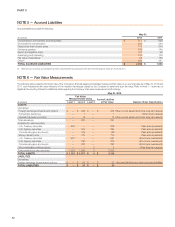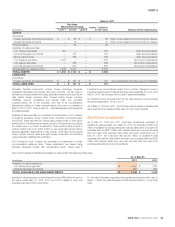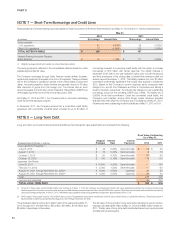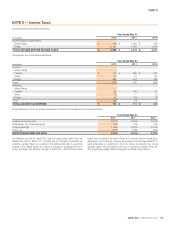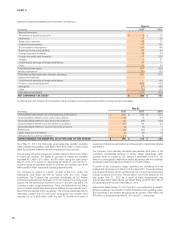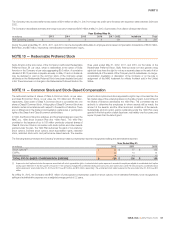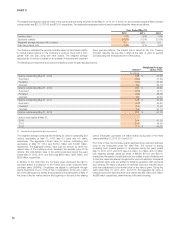Nike 2012 Annual Report Download - page 62
Download and view the complete annual report
Please find page 62 of the 2012 Nike annual report below. You can navigate through the pages in the report by either clicking on the pages listed below, or by using the keyword search tool below to find specific information within the annual report.
PART II
discontinuance of cash flow hedging because the forecasted transaction was
no longer probable of occurring were immaterial.
As of May 31, 2012, $162 million of deferred net gains (net of tax) on both
outstanding and matured derivatives accumulated in other comprehensive
income are expected to be reclassified to net income during the next 12
months concurrent with the underlying hedged transactions also being
recorded in net income. Actual amounts ultimately reclassified to net income
are dependent on the exchange rates in effect when derivative contracts that
are currently outstanding mature. As of May 31, 2012, the maximum term
over which the Company is hedging exposures to the variability of cash flows
for its forecasted transactions is 24 months.
Fair Value Hedges
The Company is also exposed to the risk of changes in the fair value of certain
fixed-rate debt attributable to changes in interest rates. Derivatives currently
used by the Company to hedge this risk are receive-fixed, pay-variable
interest rate swaps. As of May 31, 2012, all interest rate swap agreements are
designated as fair value hedges of the related long-term debt and meet the
shortcut method requirements under the accounting standards for derivatives
and hedging. Accordingly, changes in the fair values of the interest rate swap
agreements are considered to exactly offset changes in the fair value of the
underlying long-term debt. The cash flows associated with the Company’s
fair value hedges are periodic interest payments while the swaps are
outstanding, which are reflected within the cash provided by operations
component of the cash flow statement. The Company recorded no
ineffectiveness from its interest rate swaps designated as fair value hedges for
the years ended May 31, 2012, 2011, or 2010.
Net Investment Hedges
The Company also hedges the risk of variability in foreign-currency-
denominated net investments in wholly-owned international operations. All
changes in fair value of the derivatives designated as net investment hedges,
except ineffective portions, are reported in the cumulative translation
adjustment component of other comprehensive income along with the
foreign currency translation adjustments on those investments. The Company
classifies the cash flows at settlement of its net investment hedges within the
cash provided or used by investing component of the cash flow statement.
The Company assesses hedge effectiveness based on changes in forward
rates. The Company recorded no ineffectiveness from its net investment
hedges for the years ended May 31, 2012, 2011, or 2010.
Embedded Derivatives
As described above, for currencies within the factory currency exposure
indices that are neither the U.S. Dollar nor the local or functional currency of
the factory, an embedded derivative is created upon the factory’s acceptance
of NIKE’s purchase order. Embedded derivatives are treated as foreign
currency forward contracts that are bifurcated from the related purchase
order and recorded at fair value as a derivative asset or liability on the balance
sheet with their corresponding change in fair value recognized in other
expense (income), net from the date a purchase order is accepted by a
factory through the date the purchase price is no longer subject to foreign
currency fluctuations. At May 31, 2012, the notional amount of embedded
derivatives was approximately $131 million. For the year ended May 31,
2012, a $1 million gain was recorded within other expense (income), net
related to embedded derivatives. There were no amounts recognized in other
expense (income), net for the years ended May 31, 2011 or 2010.
Undesignated Derivative Instruments
The Company may elect to enter into foreign exchange forwards to mitigate
the change in fair value of specific assets and liabilities on the balance sheet
and/or the embedded derivative contracts explained above. These forwards
are not designated as hedging instruments under the accounting standards
for derivatives and hedging. Accordingly, these undesignated instruments are
recorded at fair value as a derivative asset or liability on the balance sheet with
their corresponding change in fair value recognized in other expense
(income), net, together with the re-measurement gain or loss from the hedged
balance sheet position or embedded derivative contract. The Company
classifies the cash flows at settlement from undesignated instruments in the
same category as the cash flows from the related hedged items, generally
within the cash provided by operations component of the cash flow
statement.
Credit Risk
The Company is exposed to credit-related losses in the event of
non-performance by counterparties to hedging instruments. The
counterparties to all derivative transactions are major financial institutions with
investment grade credit ratings. However, this does not eliminate the
Company’s exposure to credit risk with these institutions. This credit risk is
limited to the unrealized gains in such contracts should any of these
counterparties fail to perform as contracted. To manage this risk, the
Company has established strict counterparty credit guidelines that are
continually monitored and managed according to prescribed guidelines. The
Company also utilizes a portfolio of financial institutions either headquartered
or operating in the same countries in which the Company conducts its
business.
The Company’s derivative contracts contain credit risk related contingent
features designed to protect against significant deterioration in counterparties’
creditworthiness and their ultimate ability to settle outstanding derivative
contracts in the normal course of business. The Company’s bilateral credit
related contingent features require the owing entity, either the Company or the
derivative counterparty, to post collateral for the portion of the fair value in
excess of $50 million should the fair value of outstanding derivatives per
counterparty be greater than $50 million. Additionally, a certain level of decline
in credit rating of either the Company or the counterparty could also trigger
collateral requirements. As of May 31, 2012, the Company was in compliance
with all credit risk related contingent features and the aggregate fair value of
derivative instruments with credit risk related contingent features that were in
a net liability position was $6 million. Accordingly, the Company was not
required to post any collateral as a result of these contingent features. Given
the considerations described above, the Company considers the impact of
the risk of counterparty default to be immaterial.
NOTE 17 — Operating Segments and Related Information
Operating Segments. The Company’s operating segments are evidence of
the structure of the Company’s internal organization. The major segments are
defined by geographic regions for operations participating in NIKE Brand
sales activity excluding NIKE Golf. Each NIKE Brand geographic segment
operates predominantly in one industry: the design, development, marketing
and selling of sports and fitness footwear, apparel, and equipment. The
Company’s reportable operating segments for the NIKE Brand are: North
America, Western Europe, Central & Eastern Europe, Greater China, Japan,
and Emerging Markets. The Company’s NIKE Brand Direct to Consumer
operations are managed within each geographic segment.
The Company’s “Other” category is broken into two components for
presentation purposes to align with the way management views the
Company. The “Global Brand Divisions” category primarily represents NIKE
Brand licensing businesses that are not part of a geographic operating
segment, demand creation and operating overhead expenses that are
centrally managed for the NIKE Brand, and costs associated with product
development and supply chain operations. The “Other Businesses” category
primarily consists of the activities of Cole Haan, Converse Inc., Hurley
International LLC, NIKE Golf and Umbro Ltd. Activities represented in the
“Other” category are considered immaterial for individual disclosure.
62


